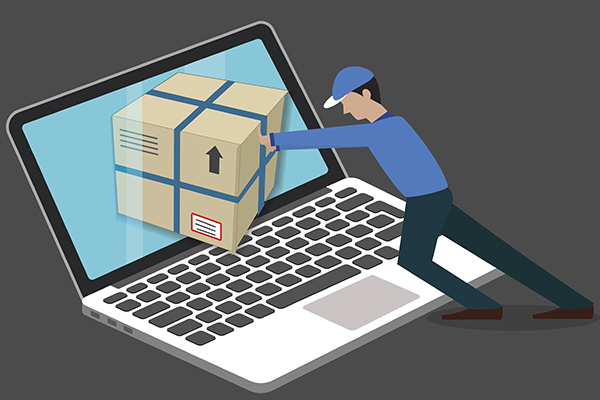Ever give a second thought to the item(s) you returned today to Amazon or WalMart? Of course not. You didn't want what you bought and they just took it back – no questions asked. Deal closed. Or is it? For you, yes. For the retailer, not even close.
Now they've got to figure out what they're going to do with your return. Can they restock it? Or resell it? Liquidate it? Give it to charity? How quickly can they do all that because there's real money to be lost here.
Reverse logistics has become so big that it now accounts for 3% of GDP. That's according to Zac Rogers, assistant professor of supply chain management at Colorado State Univ. He's been tracking returns and overstocks since 2008.
Combined, they have increased in value by 50% in that time. Today, the total is $618 billion split almost exactly evenly between the two. Rogers says that total number will exceed $1 trillion in seven or eight years. Clearly, reverse logistics is a NextGen supply chain player going forward.
Return rates are generally pegged at 8-to-9% for brick-and-mortar stores and 30-to-35% for e-commerce. This is not a trend that's going away. We're hooked. And retailers need to find more efficient ways to handle returns.
“The disposition of returns is a financial decision,” says Tony Sciarrotta, executive director of The Reverse Logistics Association. “Companies need to decide what is the least costly way to recover as much value as possible from the return,” he adds.
That has not been the case historically. Companies have typically handled returns as an afterthought at best. Returns pile up and lose value. It's all been very tactical. But with the help of new technology from processing equipment to artificial intelligence and advanced data analytics, returns can now take on a strategic role, explains John Lee of goTRG in the NextGen: The Interview.
In other words, reverse logistics is clearly moving up the NextGen supply chain ladder. But we are clearly at the early stages of the shift from tactical to strategic for returns.
Eighteen months ago, Dematic did a global study of reverse logistics. Mike Khodl, vice president of global solutions management, explains they learned three things:
- Everyone is managing returns differently
- Returns processing is chaos at best
- All are trying to figure out the optimal way to manage returns.
Experts agree that time is of the essence for managing the returns process. Khodl says Dematic's survey showed the average time to process a return was 5 days with 14 days as worst case. But time is money. The longer returns sit, the more they lose value.
To help minimize the time upfront, Dematic has developed processing workstations that organize the crediting/inspection/ repackaging/reticketing process to less than an hour. The company has also developed a pouch system that takes those processed returns and makes them available immediately to be resold. The system is currently in action at German retailer Arvato.
But not everything returns to the stock of the retailer. There are other channels including outlet retailers, salvage dealers, charities and liquidations. Each channel offers a steadily decreasing value for the merchandise. Finding the right channel is a challenge that some companies are starting to use AI to navigate, explains Sciarrotta. The value can range from 75 cents on the dollar to nothing.
The general rule of thumb is the faster a return can be returned to the supply chain, the more it is worth at the higher end channels. “Returns are poised to become a profit center rather than a cost center,” explains Rogers.
As Lee explains in NextGen: The Interview, advanced analytics and AI are teaming up with advanced software to manage return inventory in the dynamic pricing environment of multiple on-line marketplaces.
In other words, reverse logistics and returns management has become complex and costly. But to Sciarrotta, the name of the game is to better manage sales up front. “The majority of returns are because the product didn't meet the customer's expectations. This can be the result of many shortcomings on the part of the seller from poor marketing and product descriptions to inconsistently sized clothing,” he adds.
One technology approach to simplifying the returns process is the 12N QR Code, Sciarrotta explains. This label communicates key information from the manufacturer to the customer about the product from warranties to certifications and product brochures. Its use is intended to reduce avoidable returns.
It seems that we are at a crossroads in reverse logistics. The financial implications, need for speed and increasing returns marketplace complexity have put reverse logistics into a different orbit as a NextGen supply chain.
Gary Forger is special projects editor for Supply Chain Management Review. He can be reached at [email protected].
SC
MR


More Events
- Next-Gen SupplyChains: Underpinning your ability to manage complexity and drive innovation
- The Future of Supply Chains: Next-Generation Technology and Beyond
- Thanks to all who made NextGen a success
- Medline Executives’ Keynote to Kick Off NextGen Supply Chain Conference
- NextGen Supply Chain Conference 2022: About our event
- Industry Innovators Take Home 2022 NextGen Supply Chain Awards
- More Events
Latest Podcast

 Explore
Explore
Topics
Business Management News
- Technology’s role in mending supply chain fragility after recent disruptions
- Survey reveals strategies for addressing supply chain, logistics labor shortages
- How CPG brands can deliver on supplier diversity promises
- How S&OP provides the answer to in-demand products
- AI, virtual reality is bringing experiential learning into the modern age
- Tips for CIOs to overcome technology talent acquisition troubles
- More Business Management
Latest Business Management Resources

Subscribe

Supply Chain Management Review delivers the best industry content.

Editors’ Picks




